Wolfram Neural Net Repository
Immediate Computable Access to Neural Net Models
Represent text as a sequence of vectors
Released in 2018, Bidirectional Encoder Representations from Transformers (BERT) is designed to pre-train deep bidirectional representations by jointly conditioning on both left and right contexts in all layers. This model can be fine tuned with an additional output layer to create state-of-the art models for a wide range of tasks. It uses bidirectional self-attention, often referred to as a transformer encoder.
Number of models: 8
BERT Large fine-tuned on various datasets obtains the following accuracy on various natural language inference tasks: 86.7/85.9%, 72.1%, 91.1%, 94.9% 60.5%, 86.5%, 89.3%, and 70.1% accuracy on MNLI-(m/mm), QQP, QNLI, SST-2, CoLA, STS-B, MRPC, and RTE datasets respectively.
BERT Base fine-tuned on various datasets obtains the following accuracy on various natural language inference tasks: 84.6/83.4%, 71.2%, 90.1%, 93.5%, 52.1%, 85.8%, 88.9% and 66.4% accuracy on MNLI-(m/mm), QQP, QNLI, SST-2, CoLA, STS-B, MRPC, and RTE datasets respectively.
Get the pre-trained net:
| In[1]:= |
| Out[1]= |  |
This model consists of a family of individual nets, each identified by a specific parameter combination. Inspect the available parameters:
| In[2]:= |
| Out[2]= |  |
Pick a non-default net by specifying the parameters:
| In[3]:= |
| Out[3]= |  |
Pick a non-default uninitialized net:
| In[4]:= |
| Out[4]= |  |
Given a piece of text, the BERT net produces a sequence of feature vectors of size 768, which correspond to the sequence of input words or subwords:
| In[5]:= |
Obtain dimensions of the embeddings:
| In[6]:= |
| Out[6]= |
Visualize the embeddings:
| In[7]:= |
| Out[7]= |  |
Each input text segment is first tokenized into words or subwords using a word-piece tokenizer and additional text normalization. Integer codes called token indices are generated from these tokens, together with additional segment indices:
| In[8]:= | ![Copy to Clipboard net = NetModel[{"BERT Trained on BookCorpus and English Wikipedia \
Data", "InputType" -> "ListOfStrings"}];
netencoder = NetExtract[net, "Input"]](images/b51/b514b48c-51a3-468b-92f8-357c42e9e825-io-8-i.en.gif) |
| Out[9]= |  |
For each input subword token, the encoder yields a pair of indices that correspond to the token index in the vocabulary, and the index of the sentence within the list of input sentences:
| In[10]:= |
| Out[10]= |
The list of tokens always starts with special token index 102, which corresponds to the classification index. Also the special token index 103 is used as a separator between the different text segments. Each subword token is also assigned a positional index:
| In[11]:= |
| Out[11]= |
A lookup is done to map these indices to numeric vectors of size 768:
| In[12]:= | ![Copy to Clipboard embeddings = net[{"Hello world!", "I am here"},
{NetPort[{"embedding", "embeddingpos", "Output"}],
NetPort[{"embedding", "embeddingtokens", "Output"}],
NetPort[{"embedding", "embeddingsegments", "Output"}]}];
Map[MatrixPlot, embeddings]](images/b51/b514b48c-51a3-468b-92f8-357c42e9e825-io-12-i.en.gif) |
| Out[13]= | 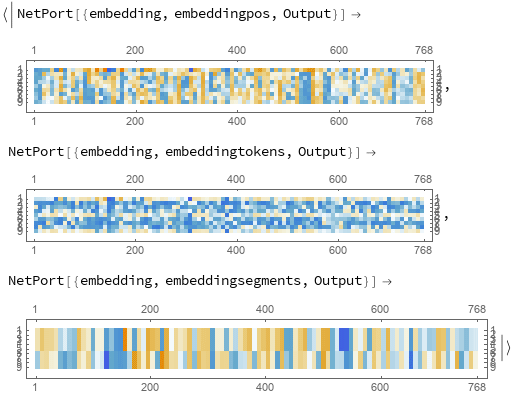 |
For each subword token, these three embeddings are combined by summing elements with ThreadingLayer:
| In[14]:= |
| Out[14]= | 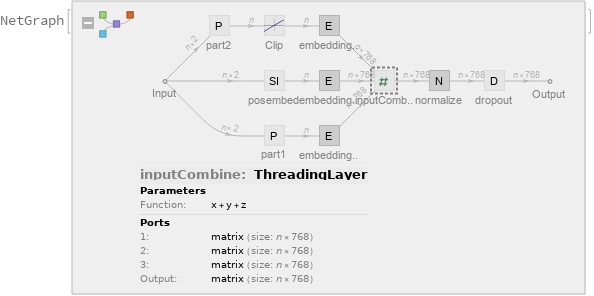 |
The transformer architecture then processes the vectors using 12 structurally identical self-attention blocks stacked in a chain:
| In[15]:= |
| Out[15]= | 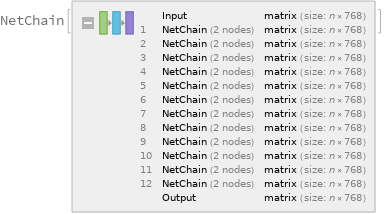 |
The key part of these blocks is the attention module comprising of 12 parallel self-attention transformations, also called “attention heads”:
| In[16]:= |
| Out[16]= | 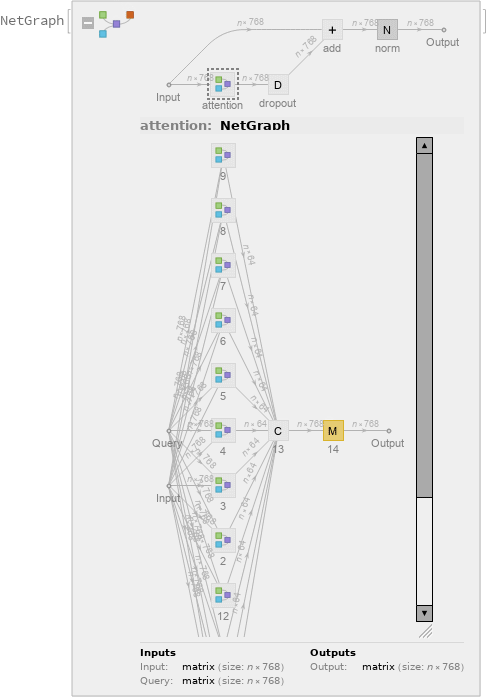 |
Each head uses an AttentionLayer at its core:
| In[17]:= |
| Out[17]= | 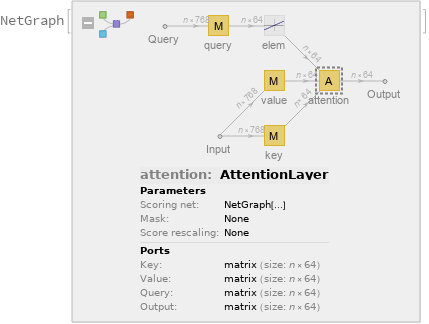 |
BERT uses self-attention, where the embedding of a given subword depends on the full input text. The following figure compares self-attention (lower left) to other types of connectivity patterns that are popular in deep learning:
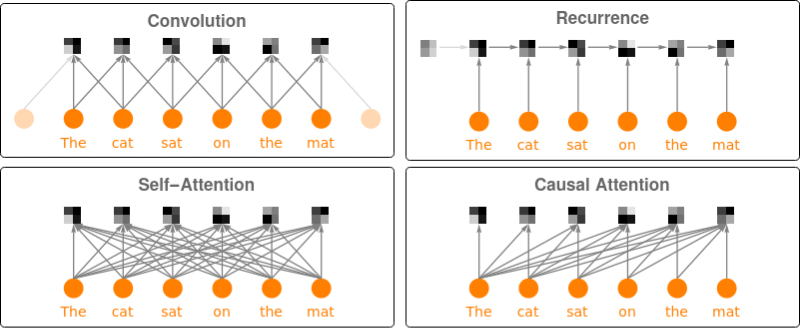
Define a sentence embedding that takes the last feature vector from BERT subword embeddings (as an arbitrary choice):
| In[18]:= |
| Out[18]= |  |
Define a list of sentence in two broad categories (food and music):
| In[19]:= |  |
Precompute the embeddings for a list of sentences:
| In[20]:= |
Visualize the similarity between the sentences using the net as a feature extractor:
| In[21]:= |
| Out[21]= | 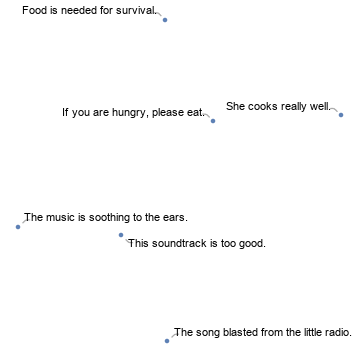 |
Get a text-processing dataset:
| In[22]:= |
View a random sample of the dataset:
| In[23]:= |
| Out[23]= |  |
Precompute the BERT vectors for the training and the validation datasets (if available, GPU is highly recommended):
| In[24]:= | ![Copy to Clipboard trainembeddings =
NetModel["BERT Trained on BookCorpus and English Wikipedia Data"][
train[[All, 1]], TargetDevice -> "CPU"] -> train[[All, 2]];
validembeddings =
NetModel["BERT Trained on BookCorpus and English Wikipedia Data"][
valid[[All, 1]], TargetDevice -> "CPU"] -> valid[[All, 2]];](images/b51/b514b48c-51a3-468b-92f8-357c42e9e825-io-24-i.en.gif) |
Define a network to classify the sequences of subword embeddings, using a max-pooling strategy:
| In[25]:= | ![Copy to Clipboard classifierhead =
NetChain[{DropoutLayer[], NetMapOperator[2],
AggregationLayer[Max, 1], SoftmaxLayer[]},
"Output" -> NetDecoder[{"Class", {"negative", "positive"}}]]](images/b51/b514b48c-51a3-468b-92f8-357c42e9e825-io-25-i.en.gif) |
| Out[25]= |  |
Train the network on the precomputed BERT vectors:
| In[26]:= | ![Copy to Clipboard bertresults = NetTrain[classifierhead, trainembeddings, All,
ValidationSet -> validembeddings,
TargetDevice -> "CPU",
MaxTrainingRounds -> 50]](images/b51/b514b48c-51a3-468b-92f8-357c42e9e825-io-26-i.en.gif) |
| Out[26]= | 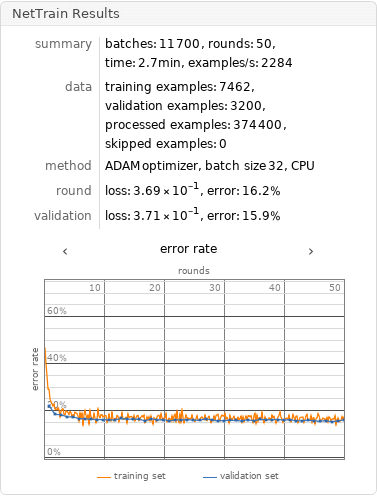 |
Check the classification error rate on the validation data:
| In[27]:= |
| Out[27]= |
Let’s compare the results with the performance of a classifier trained on context-independent word embeddings. Precompute the GloVe vectors for the training and the validation dataset:
| In[28]:= | ![Copy to Clipboard trainembeddingsglove =
NetModel["GloVe 300-Dimensional Word Vectors Trained on Wikipedia \
and Gigaword 5 Data"][train[[All, 1]], TargetDevice -> "CPU"] ->
train[[All, 2]];
validembeddingsglove =
NetModel["GloVe 300-Dimensional Word Vectors Trained on Wikipedia \
and Gigaword 5 Data"][valid[[All, 1]], TargetDevice -> "CPU"] ->
valid[[All, 2]];](images/b51/b514b48c-51a3-468b-92f8-357c42e9e825-io-28-i.en.gif) |
Train the classifier on the precomputed GloVe vectors:
| In[29]:= | ![Copy to Clipboard gloveresults = NetTrain[classifierhead, trainembeddingsglove, All,
ValidationSet -> validembeddingsglove,
TrainingStoppingCriterion -> <|"Criterion" -> "ErrorRate",
"Patience" -> 50|>,
TargetDevice -> "CPU",
MaxTrainingRounds -> 50]](images/b51/b514b48c-51a3-468b-92f8-357c42e9e825-io-29-i.en.gif) |
| Out[29]= | 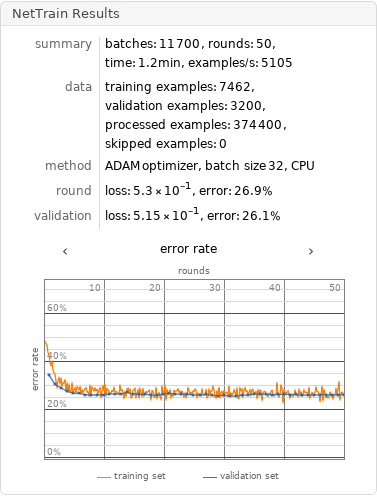 |
Compare the results obtained with GPT and with GloVe:
| In[30]:= |
| Out[30]= |  |
Inspect the number of parameters of all arrays in the net:
| In[31]:= |
| Out[31]= |  |
Obtain the total number of parameters:
| In[32]:= |
| Out[32]= |
Obtain the layer type counts:
| In[33]:= |
| Out[33]= |  |
Display the summary graphic:
| In[34]:= |
| Out[34]= |
Wolfram Language 12.0 (April 2019) or above